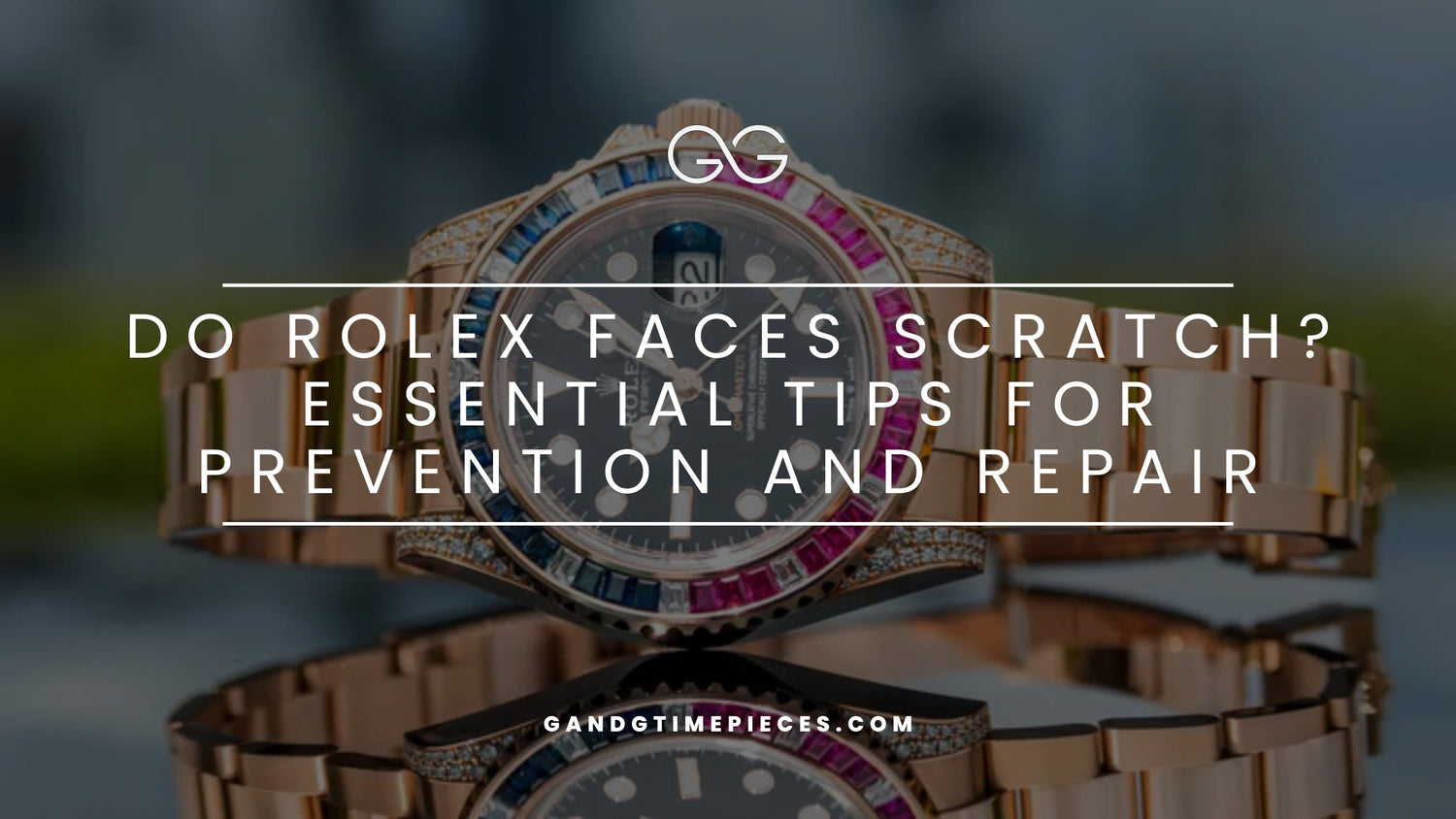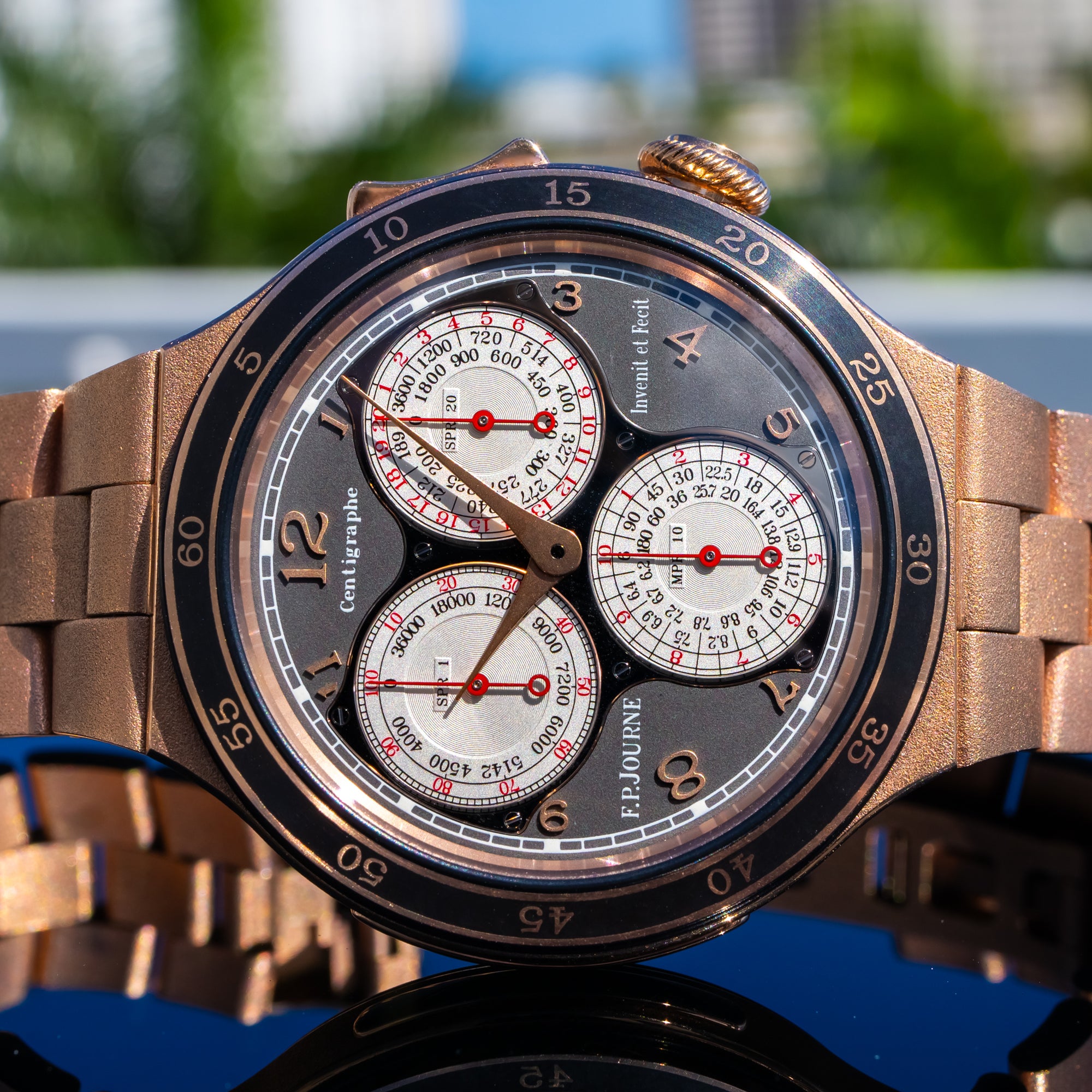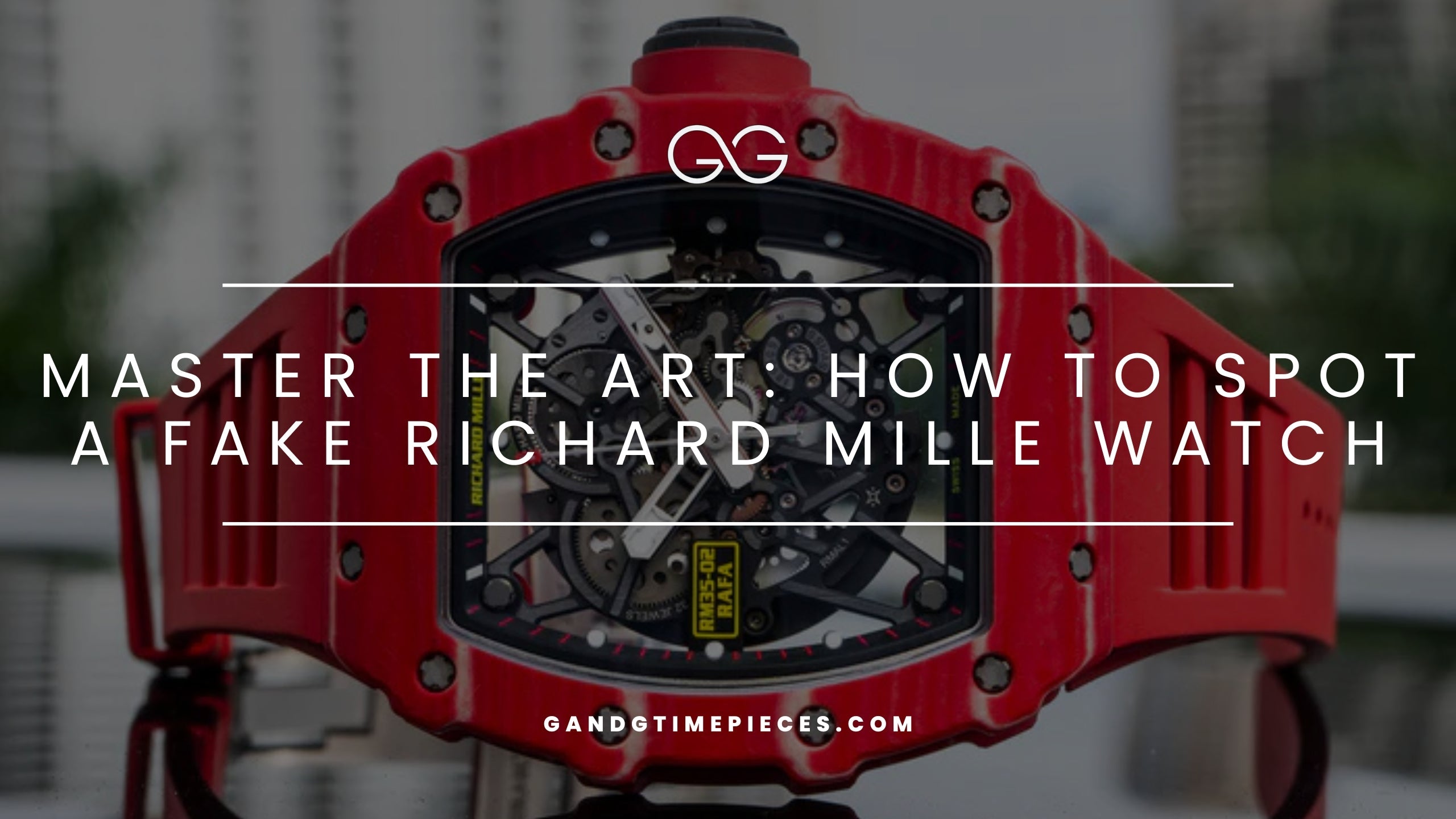While Rolex's watch faces are made of scratch-resistant sapphire crystal, they are not entirely immune to damage. This article covers reasons Rolex faces scratch, prevention tips, and repair options.
Key Takeaways
-
Rolex watches use sapphire crystals, which are highly scratch-resistant, but they’re not immune to damage from hard surfaces or sharp objects.
-
To prevent scratches, handle your Rolex carefully, avoid physical activities while wearing it, and use protective films or designated storage.
-
For minor scratches, professional polishing can restore the watch’s shine, while deep scratches may require extensive repair or crystal replacement to maintain value.
Understanding Rolex Watch Faces
Rolex watches have long been celebrated for their durability and elegance, with much of this reputation stemming from the materials used in their construction. Since the 1970s, Rolex has utilized sapphire crystals for their watch faces, a material known for its exceptional hardness and resistance to scratches. Ranking just below diamonds on the Mohs hardness scale, sapphire crystal ensures that your Rolex can withstand the rigors of daily wear and tear without easily showing signs of damage.
However, not all materials are created equal when it comes to scratch-resistant properties. For instance, while gold is undeniably luxurious, it is also more prone to deep scratches compared to stainless steel. This means that the material of your Rolex watch affects how scratches manifest and how they can be treated.
Knowing the composition of your Rolex watch face helps you appreciate its resilience and care for it properly. Whether your Rolex is a contemporary model or a cherished vintage piece, recognizing the strengths and vulnerabilities of its materials will guide you in maintaining its pristine appearance.
Common Causes of Scratches on Rolex Faces
Even though Rolex watches are crafted with durable materials, they are not totally immune to scratches. One of the most common culprits is accidental contact with hard surfaces. Imagine wearing your Rolex while working around the house or running errands—a diamond ring or a granite countertop can easily leave a mark on your watch face.
Another frequent cause of scratches is bumping into sharp objects or edges. Whether navigating through crowded spaces or having an active day, it’s easy to inadvertently knock your Rolex against something sharp, leading to chips or scratches on the watch’s crystal. Despite the robustness of sapphire crystal, certain impacts can still cause damage.
Everyday wear also contributes to the gradual accumulation of minor scratches. From putting your hands in your pockets to brushing against surfaces, these seemingly insignificant actions can add up over time, especially for those who wear their Rolexes daily. Recognizing these common causes allows you to take preventative measures to protect your treasured timepiece.
Preventing Scratches on Your Rolex

Careful handling and strategic usage can prevent scratches on your Rolex. To protect your Rolex, avoid wearing it during physically demanding activities. If you plan to hit the gym or do some heavy lifting, it’s best to leave your watch in a safe place to minimize the risk of accidental impact.
Wearing your Rolex on special occasions instead of daily can help preserve its condition. This doesn’t mean you shouldn’t enjoy your watch, but being selective about when you wear it can significantly reduce the chances of it getting scratched.
Store your Rolex in a designated box or pouch when you aren't using it. This simple habit can prevent accidental scratches that might occur if your watch is left out in the open or mixed with other items. You should also regularly clean your watch with a soft cloth and mild soapy water to eliminate particles that could scratch the face.
Consider using a protective film designed for Rolex watches. These films provide an additional defense against scratches, ensuring that your Rolex remains immaculate for years.
Assessing the Damage: Minor vs. Deep Scratches
Understanding the difference between minor and deep scratches is crucial for proper maintenance. Minor scratches are generally surface-level blemishes that don’t affect the watch’s functionality. A professional can often polish these out, restoring the watch’s original shine.
However, deep scratches pose a more significant threat. Seek professional help immediately if a scratch affects the watch’s functioning or if the sapphire crystal is shattered. Deep scratches compromise the watch’s appearance and can jeopardize its internal components if not addressed promptly.
Repair deep scratches promptly to prevent further damage and preserve your Rolex’s value. Ignoring these issues can lead to more extensive and costly repairs down the line. Proactively assessing and addressing scratches ensures your Rolex remains a reliable and beautiful timepiece.
Professional Repair Options for Scratched Rolex Faces
Professional intervention is often the best course of action for repairing a scratched Rolex. Minor surface scratches can usually be polished out to restore the watch’s pristine appearance. However, deeper scratches might necessitate more extensive repairs, such as replacing the crystal.
A detailed inspection and cleaning process is essential before any repair. This ensures that all potential issues are identified and addressed. The quality of the restoration largely depends on the skills of the watchmaker, making it crucial to choose a reputable professional.
In cases of severe damage, a complete dial replacement might be necessary. This is more complex and costly, varying based on the model and materials of the watch. Make sure the watchmaker uses genuine Rolex parts to maintain the watch’s authenticity and value.
Cost of Repairing Scratched Rolex Faces

Repair costs for a scratched Rolex vary significantly based on the extent of damage and the watch model. Repair costs for minor scratches typically start at a few hundred dollars. These simple fixes involve polishing the surface to remove blemishes.
However, depending on the severity of the damage, extensive repairs can cost several hundred to several thousand dollars. For instance, replacing a shattered sapphire crystal or performing a complete dial replacement will incur higher costs.
Factors such as repair complexity and model exclusivity influence repair costs. Models like the Rolex Submariner or Rolex Daytona might need more specialized and costly services. Understanding these cost dynamics helps in planning and budgeting for potential repairs.
Maintaining the Value and Authenticity of Your Rolex
To maintain your Rolex's value and authenticity, use authentic parts during repairs and get regular servicing at authorized centers. Genuine components ensure your watch retains its original condition and functionality.
Certified Rolex service centers are crucial for preserving the watch’s resale value and authenticity. These centers can access genuine parts and provide specialized attention to your timepiece. Thorough service records demonstrate the watch’s authenticity and history, improving its resale value.
DIY scratch removal is risky and can cause further damage. Improper techniques may compromise the watch’s integrity, so rely on professionals. Independent repair services might offer quicker and cheaper options but often use non-genuine parts, diminishing the watch’s value.
Repairing a Rolex often preserves its historical significance and market value better than replacing it. This approach maintains the watch’s charm and continues its legacy.
The Charm of Vintage Timepieces
Vintage Rolex watches have a unique charm, and scratches are often viewed as badges of honor. These marks tell the story of the watch’s journey, adding character and history that collectors find appealing.
Modern luxury watches are typically kept pristine, while vintage timepieces with scratches are cherished for their authenticity and history. Each scratch testifies to the life the watch has led, making it a more personal and storied piece. A new watch can also be a valuable addition to any collection.
A pristine vintage Rolex is rare and highly valued among collectors. These unworn examples are special due to their rarity and impeccable condition over the years.
Worn or pristine, vintage Rolexes possess a timeless allure that captivates enthusiasts.
When to Consider Replacing the Crystal
By inspecting your Rolex crystal for scratches or cracks, you can determine when replacement is necessary. A significantly damaged crystal affects appearance and can compromise the watch’s functionality.
Crystal replacement for vintage or discontinued models might require specialized services and be costlier. Replacing the crystal may be essential to maintain the watch’s quality and functionality.
Choosing the Right Service Center
Selecting the right service center ensures high-quality repairs. Although a certified reputable watchmaker may be costlier, they provide the expertise and tools for proper restoration.
Seek reviews and recommendations from previous customers before proceeding with repairs. This helps assess the service center’s reputation and ensures you entrust your Rolex to skilled professionals.
Summary
Knowing how you might scratch your Rolex will help you take preventative measures to keep it safe, which can go a long way toward maintaining its pristine condition. Regular professional servicing and using genuine parts are crucial for preserving the watch’s value and authenticity.
Repairing scratches promptly prevents further damage and ensures your Rolex remains a reliable and elegant timepiece. Whether you own a modern Rolex or a vintage piece, proper care and maintenance are key to enjoying your watch for years.
By following these guidelines, you can keep your Rolex in top condition, safeguarding its legacy and value for future generations.
Frequently Asked Questions
What materials are Rolex watch faces made from?
Rolex watch faces are crafted from sapphire crystals, which are incredibly hard and scratch-resistant, ensuring your timepiece stays looking pristine.
How can I prevent scratches on my Rolex?
To prevent scratches on your Rolex, avoid wearing it during rough activities, store it safely, clean it regularly, and think about using a protective film. Keeping your watch well-maintained will help it shine for years to come!
What should I do if my Rolex has deep scratches?
If your Rolex has deep scratches, it's best to seek professional help right away to avoid further damage and ensure it stays functional. Don't hesitate to take it to an authorized service center for the best care!
How much does it cost to repair a scratched Rolex?
Depending on the damage and model, repairing a scratched Rolex typically costs a few hundred to several thousand dollars. For an accurate estimate, getting a quote from an authorized service center is best.
Why is it important to use genuine Rolex parts during repairs?
Using genuine Rolex parts for repairs is essential because they help maintain the watch's original condition, value, and functionality. This preservation of authenticity keeps your investment safe and sound.





